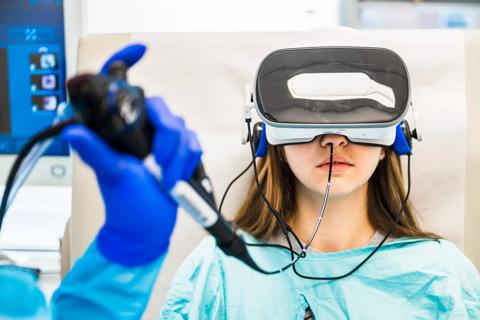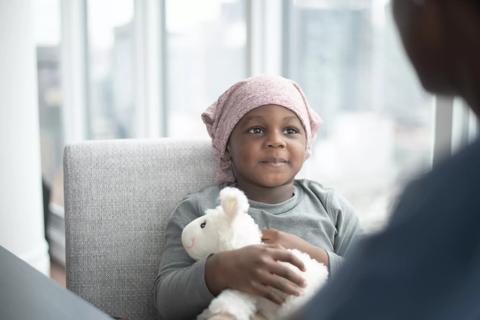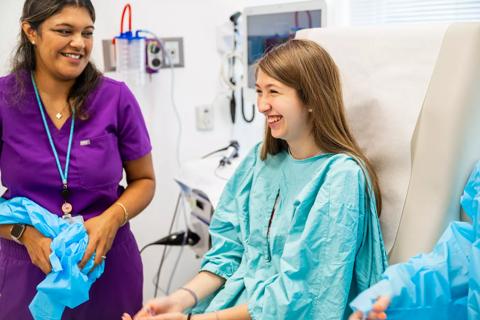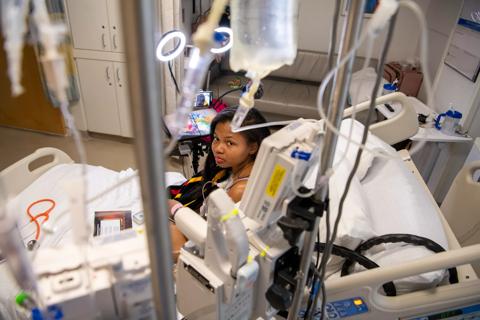Considerations for re-entry to school and sports participation

Patient and graft survival in pediatric solid organ transplant has markedly improved over the last several decades. For pediatric transplant physicians, the primary goal has shifted from short-term survival following transplant to a focus on longer-term outcomes and quality of life.
Cleveland Clinic is a non-profit academic medical center. Advertising on our site helps support our mission. We do not endorse non-Cleveland Clinic products or services. Policy
Amy Bobrowski, MD, a pediatric nephrologist at Cleveland Clinic Children’s, authored an article examining key concerns as patients return to school and sports participation following transplant. The article was published in Pediatric Transplantation.
“These patients have gone through so much with their end-organ illness, and it’s wonderful and exciting when they finally get to transplant; but, it’s not a cure. It’s a different chronic illness we now need to manage,” says Dr. Bobrowski.
She offers several preventive considerations to help patients and families navigate the child’s re-entry to school.
Exposure to infectious diseases is of particular concern for this immunosuppressed patient population. She says hand hygiene, appropriate distancing in crowded spaces, and mask-wearing in certain situations are all effective strategies that have become more normalized during the COVID-19 pandemic.
Communication and clear guidance are also key. Emergency plans should be readily available to teachers, school nurses and school officials in the event of an illness or injury.
Additionally, she encourages parents to work with school administration to be sure sick days and vaccination-related policies are reinforced within the school community.
“Many transplant patients are not able to receive or may not respond well to all vaccines, and communicable diseases can be really dangerous for this patient population. School personnel must be mindful of the child’s vulnerable immune system.”
Managing social reintegration, cognitive development and mental health as a student re-enters school is highly patient- and family-specific. “Every child is different and every situation is different – the timing of their illness, their stage of development, and any underlying conditions all play a role in how to counsel the patient and family.”
Her advice? Involve social workers early on in the process to enhance communication and cultivate resources to help navigate potential challenges. School-based programming can support communication about the patient’s medical event with classmates and school administration, which may reduce patient anxiety and provide clear guidelines and expectations.
Social workers can also help facilitate neurocognitive testing, potentially leading to an individualized educational plan. This is important, Dr. Bobrowski explains, because patients who have undergone solid organ transplant have an increased risk of neurocognitive barriers, either due to underlying syndromes or, in some cases, related to the course of treatment.
Mental health issues are also not uncommon in this patient population. Dr. Bobrowski advocates for education and awareness in primary and pediatric care settings to screen for potential mental health concerns.
Promoting physical activity in this patient population has become increasingly important. With hypertension and obesity both common after kidney transplant, research has shown that these patients are at risk for premature incidence of cardiovascular disease.
Providers can be more encouraging about integrating physical activity in their post-transplant counseling. This means being as emphatic about exercise and activity in the rehabilitation phase as we are about rest and inactivity in the postoperative phase, asserts Dr. Bobrowski.
“Doing activity ‘as tolerated’ is a nonspecific recommendation that is hard for patients to actually follow and get adequate exercise, so I think that’s something we are starting to realize requires more specificity and more resources. This is a conversation that, again, should start earlier, and be as important as fluid intake and medication management,” she says.
Guidance is, of course, patient-specific. In the case of kidney transplant, guidance is to avoid collision or high-contact sports because of the location of the transplanted kidney – it’s not as protected as a native kidney because of its location. However, it’s worth noting that “the risk of cardiovascular disease is much higher in transplant patients than the risk of organ trauma from being physically active,” she says.
Improving guidance on rehabilitation for this patient population requires more interventional studies with long-term outcomes. The longer-term data simply don’t exist right now. “Some of these data could be extrapolated from adult studies, but it’s still a different patient population, and that’s a limitation. Part of the problem is that we just don’t have that length of time right now, considering the relative recency of these good pediatric transplant outcomes.”
She says, ultimately, it’s a balancing act. “We don’t want these patients to live in fear; the goal is a safe return to normalcy. With the right counseling, we can help optimize outcomes, while they get back to being a kid again.”

Considerations and challenges in pediatric transplantation

IBAT inhibitors, elastography and more

Programs bring age- and size-appropriate technology to children

Unpacking advancements and identifying drivers of inequity

Self-efficacy mindset, burst therapy and increased biofeedback may help improve outcomes

Pediatric and adult gastroenterologists offer team care for patients with eosinophilic esophagitis

New guidelines expand on psychosocial, sexual health, cognitive and other issues

Consensus conference begins work on new recommendations for clinical care and research